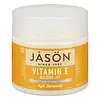What's inside
What's inside
 Key Ingredients
Key Ingredients

 Benefits
Benefits

 Concerns
Concerns

 Ingredients Side-by-side
Ingredients Side-by-side

Water
Skin ConditioningTocopheryl Acetate
AntioxidantGlycerin
HumectantCetyl Alcohol
EmollientStearic Acid
CleansingCaprylic/Capric Triglyceride
MaskingDimethicone
EmollientGlyceryl Stearate Se
EmulsifyingHelianthus Annuus Seed Oil
EmollientPersea Gratissima Oil
Skin ConditioningCitrus Grandis Fruit Extract
AstringentAscorbic Acid
AntioxidantCarbomer
Emulsion StabilisingPotassium Cetyl Phosphate
EmulsifyingPotassium Hydroxide
BufferingSorbic Acid
PreservativeBenzyl Alcohol
PerfumingPhenoxyethanol
PreservativePotassium Sorbate
PreservativeSodium Benzoate
MaskingWater, Tocopheryl Acetate, Glycerin, Cetyl Alcohol, Stearic Acid, Caprylic/Capric Triglyceride, Dimethicone, Glyceryl Stearate Se, Helianthus Annuus Seed Oil, Persea Gratissima Oil, Citrus Grandis Fruit Extract, Ascorbic Acid, Carbomer, Potassium Cetyl Phosphate, Potassium Hydroxide, Sorbic Acid, Benzyl Alcohol, Phenoxyethanol, Potassium Sorbate, Sodium Benzoate
Water
Skin ConditioningTocopheryl Acetate
AntioxidantGlycerin
HumectantCarthamus Tinctorius Seed Oil
MaskingCetyl Alcohol
EmollientStearic Acid
CleansingGlyceryl Stearate
EmollientPersea Gratissima Oil
Skin ConditioningSesamum Indicum Seed Oil
EmollientHelianthus Annuus Seedcake
AbrasiveErigeron Annuus Flower Oil
Skin ConditioningPanthenol
Skin ConditioningAloe Barbadensis Leaf Juice
Skin ConditioningAllantoin
Skin ConditioningCetearyl Glucoside
EmulsifyingGlyceryl Stearate Se
EmulsifyingGlyceryl Stearate Citrate
EmollientPolysorbate 60
EmulsifyingSodium Hydroxide
BufferingPhenoxyethanol
PreservativeEthylhexylglycerin
Skin ConditioningParfum
MaskingWater, Tocopheryl Acetate, Glycerin, Carthamus Tinctorius Seed Oil, Cetyl Alcohol, Stearic Acid, Glyceryl Stearate, Persea Gratissima Oil, Sesamum Indicum Seed Oil, Helianthus Annuus Seedcake, Erigeron Annuus Flower Oil, Panthenol, Aloe Barbadensis Leaf Juice, Allantoin, Cetearyl Glucoside, Glyceryl Stearate Se, Glyceryl Stearate Citrate, Polysorbate 60, Sodium Hydroxide, Phenoxyethanol, Ethylhexylglycerin, Parfum
Ingredients Explained
These ingredients are found in both products.
Ingredients higher up in an ingredient list are typically present in a larger amount.
Cetyl Alcohol is a fatty alcohol. Fatty Alcohols are most often used as an emollient or to thicken a product.
Its main roles are:
Though it has "alcohol" in the name, it is not related to denatured alcohol or ethyl alcohol.
The FDA allows products labeled "alcohol-free" to have fatty alcohols.
Learn more about Cetyl AlcoholGlycerin is already naturally found in your skin. It helps moisturize and protect your skin.
A study from 2016 found glycerin to be more effective as a humectant than AHAs and hyaluronic acid.
As a humectant, it helps the skin stay hydrated by pulling moisture to your skin. The low molecular weight of glycerin allows it to pull moisture into the deeper layers of your skin.
Hydrated skin improves your skin barrier; Your skin barrier helps protect against irritants and bacteria.
Glycerin has also been found to have antimicrobial and antiviral properties. Due to these properties, glycerin is often used in wound and burn treatments.
In cosmetics, glycerin is usually derived from plants such as soybean or palm. However, it can also be sourced from animals, such as tallow or animal fat.
This ingredient is organic, colorless, odorless, and non-toxic.
Glycerin is the name for this ingredient in American English. British English uses Glycerol/Glycerine.
Learn more about GlycerinGlyceryl Stearate Se is a self-emulsifying (SE) form of glyceryl stearate. Self-emusifying means this ingredient automatically blends with water. It is an emulsifier, emollient, and cleansing agent.
As an emulsifier, Glyceryl Stearate Se prevents ingredients such as oil and water from separating. It is also a surfactant, meaning it helps cleanse the skin. Surfactants help gather oil, dirt, and other pollutants so they may be rinsed away easily.
Emollients help your skin stay smooth and soft. It does so by creating a film on top of the skin that helps trap moisture in.
Learn more about Glyceryl Stearate SePersea Gratissima Oil is also known as avocado oil.
Avocado Oil has antioxidant properties. It is mostly made up of the glycerides of fatty acids. About 67% of these fatty acids is made up of oleic acid. Palmitic acid and linoleic acid are also present.
These fatty acids help hydrate and soften the skin. It may increase collagen content in the skin. Collagen helps keep your skin plump and firm. This ingredient helps reduce inflammation and has not shown to clog pores.
This ingredient may not be fungal-acne safe due to its high fatty acid content.
Avocados also have B vitamins, vitamin K, vitamin C, vitamin E, and potassium.
Learn more about Persea Gratissima OilPhenoxyethanol is a preservative that has germicide, antimicrobial, and aromatic properties. Studies show that phenoxyethanol can prevent microbial growth. By itself, it has a scent that is similar to that of a rose.
It's often used in formulations along with Caprylyl Glycol to preserve the shelf life of products.
Stearic Acid is a fatty acid. It is an emollient, emulsifier, and texture enhancer.
As an emollient, stearic acid helps soften skin. It aids the skin's protective barrier by preventing water loss. It also provides a gentle cleansing effect without stripping away natural oils.
Stearic acid may also be used to enhance the texture of products. It can add volume and stabilize ingredients such as water and oil. This can help water and oil ingredients from separating.
Sources of stearic acid include animal or vegetable fats/oils such as coconut or shea. It can be naturally found in butter, cocoa butter, shea butter, vegetable fats, and animal tallow.
This ingredient may not be Malassezia folliculitis, or fungal-acne safe.
Learn more about Stearic AcidTocopheryl Acetate is AKA Vitamin E. It is an antioxidant and protects your skin from free radicals. Free radicals damage the skin by breaking down collagen.
One study found using Tocopheryl Acetate with Vitamin C decreased the number of sunburned cells.
Tocopheryl Acetate is commonly found in both skincare and dietary supplements.
Learn more about Tocopheryl AcetateWater. It's the most common cosmetic ingredient of all. You'll usually see it at the top of ingredient lists, meaning that it makes up the largest part of the product.
So why is it so popular? Water most often acts as a solvent - this means that it helps dissolve other ingredients into the formulation.
You'll also recognize water as that liquid we all need to stay alive. If you see this, drink a glass of water. Stay hydrated!
Learn more about Water